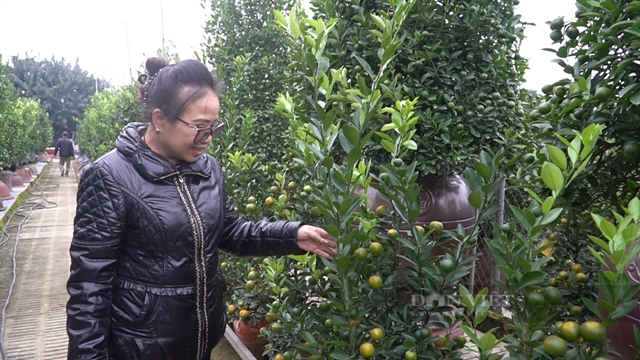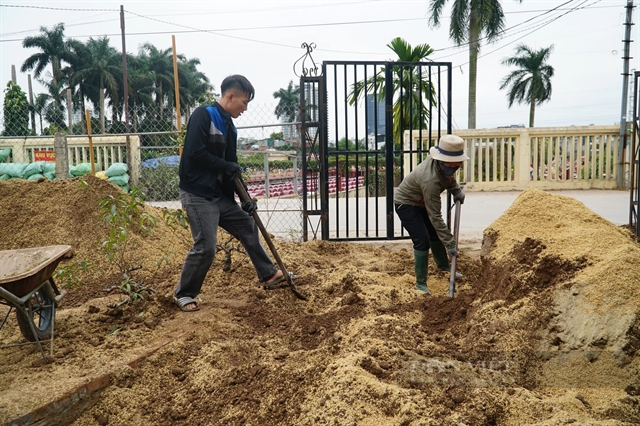 |
| A customer at a kumquat tree garden in Tứ Liên Ward, Tây Hồ District, Hà Nội. — Photo danviet.vn |
HÀ NỘI — Kumquat and peach growers in Hà Nội are busy taking care their trees before bringing them to the market when there is about one month left until Tết (Lunar New Year).
Lê Anh Dũng, 63, of Tứ Liên Ward, Tây Hồ District, said he had 30 years of experience growing bonsai kumquat trees. His garden now had about 300 kumquat trees.
Recently, he has been working very hard at his garden every day to take care of the bonsai kumquat trees in order to meet the demand of people during the Tết holidays.
It normally costs about VNĐ500,000 – 700,000 (US$20-28) for a bonsai kumquat tree from his garden, depending on its size, he said.
“Old bonsai kumquat trees with ripe, young and green fruits during Tết, which symbolises many generations in a family – according to the conception of many Vietnamese, will cost up to tens of millions of đồng each,” he told Dân Việt (Vietnamese people) online newspaper.
He said the technique of growing kumquat trees so that they had ripe fruits during Tết was very elaborate.
“Only having experience is not enough, it also depends on the weather,” he added.
According to Dũng, the cold weather this year came later than in previous years. Additionally, it could not be predicted if the weather would be warmer or colder until Tết.
“If the weather is warmer than now, it encourages the kumquat trees to ripen, if not, the growers will have to work hard to make the fruits ripen during Tết,” he said.
In another kumquat tree garden, Nguyễn Văn Hưng, 60, was carefully tying steel wires to his ornamental kumquat trees.
He said this helps shape the kumquat trees properly.
Hưng said the more fruits a kumquat tree had, the more water it absorbed.
“At this time, I have to be very careful in giving water to the trees. If too much water is given, the trees’ roots will be damaged,” he said.
It is estimated that there are about 400 households growing kumquat trees, covering a total of 15ha, in the ward.
Local kumquat growers said they expected the peak consumption period for kumquat trees would be in the middle of the 12th lunar month.
In the meantime, peach growers in Nhật Tân Ward, are quickly mixing bags of rice husks with the soil.
 |
| Local growers mix rice husks with the soil to reduce pests and diseases for peach trees in Nhật Tân Ward, Tây Hồ District, Hà Nội. — Photo danviet.vn |
Nguyễn Văn Hải, 32, owner of a peach garden, said this step was carried out before putting the peach trees in pots to sell to people for Tết. Mixing rice husks with the soil helps to reduce pests and diseases for the trees.
He also said that before mixing the rice husks with the soil, peach growers would pluck leaves from the peach trees. The leave plucking often started about 30-40 days before Tết.
The final stage was digging the peach trees from the garden and putting them in pots for selling in the market, he said.
Hải said he also planted some wild peach trees to serve the diverse demand of customers in his garden.
Customers often started to buy peach trees from the beginning of the 12th lunar month and the demand would be strongest in the middle of the month, he said.
His garden had about 300 peach trees. It cost about VNĐ2-3 million ($82-122) for a small tree, and tens of millions of đồng for a big, old tree.
This year’s price would be slightly higher than previous years, because the costs of labour and fertiliser were also higher than previous years, he said.
Nguyễn Thị Liên, a seasonal worker at the garden, said she earned about VNĐ300,000 – 500,000 ($12-20) for four hours working at the garden. — VNS
- Reduce Hair Loss with PURA D’OR Gold Label Shampoo
- Castor Oil Has Made a “Huge” Difference With Hair and Brow Growth
- Excessive hair loss in men: Signs of illness that cannot be subjective
- Dịch Vụ SEO Website ở Los Angeles, CA: đưa trang web doanh nghiệp bạn lên top Google
- Nails Salon Sierra Madre
 VnExpress News The News Gateway of Vietnam
VnExpress News The News Gateway of Vietnam





